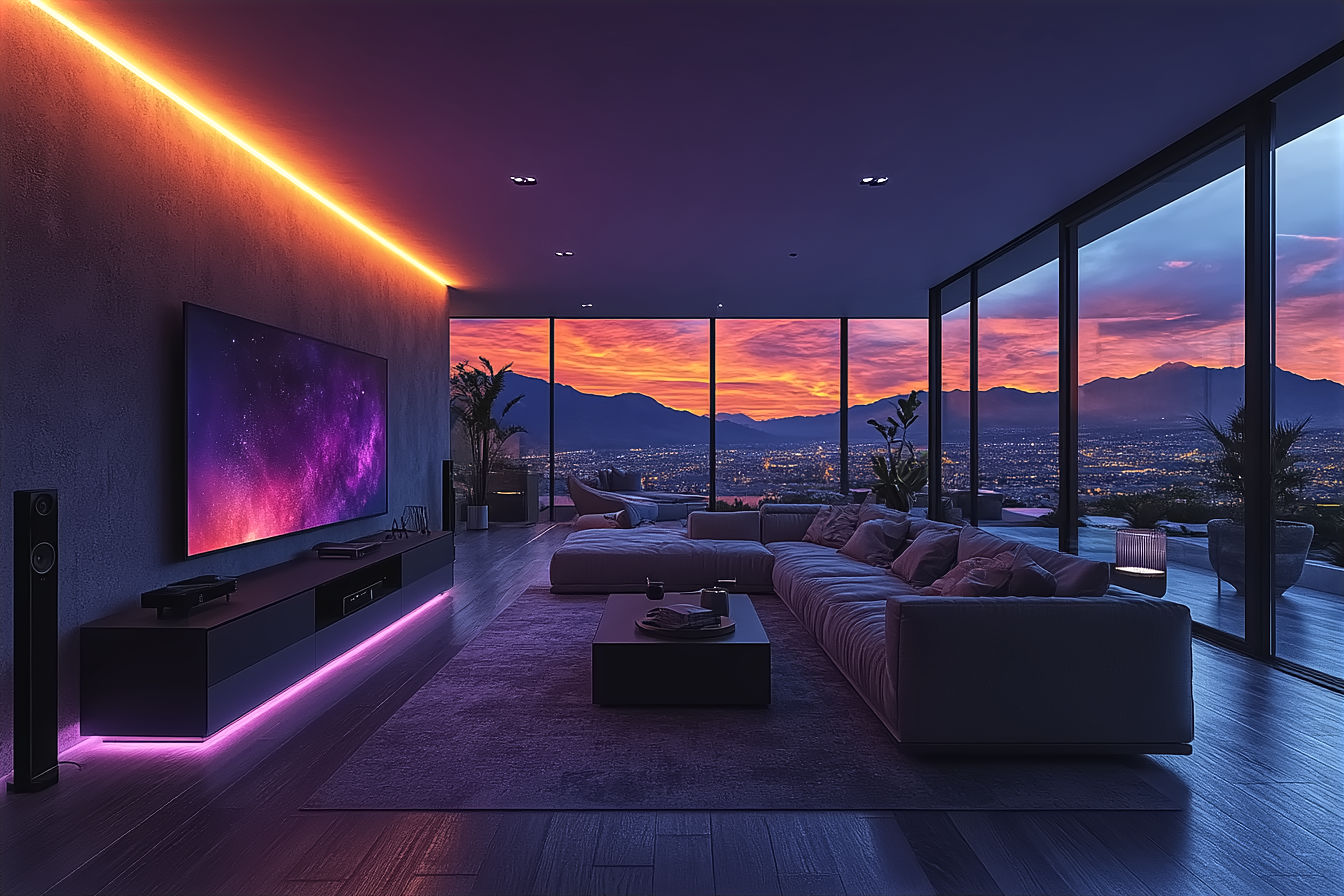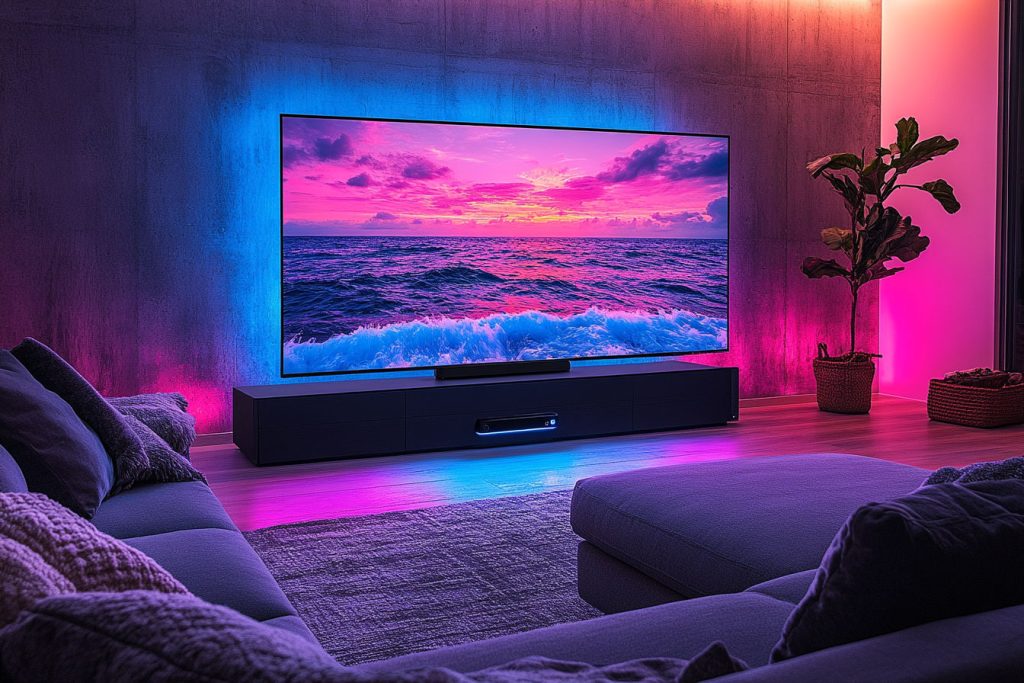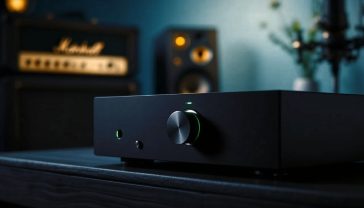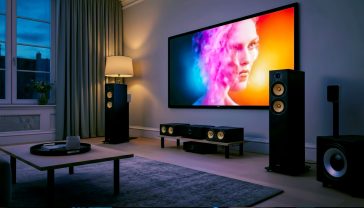Top 10 Home Theatre Brands: The Best in Audio-Visual
Want to elevate your home theatre? Explore the top brands renowned for cutting-edge technology, superior sound, and stunning visuals. Which brand is best for your setup?

This post may contain affiliate links. If you make a purchase through these links, we may earn a commission at no additional cost to you.
Home theatre systems have turned living rooms into cinematic sanctuaries, fueled by the rise of streaming giants, blockbuster gaming, and a post-pandemic craving for premium home entertainment. Choosing the right brand isn’t just about sound and picture—it’s about investing in a system that fits your space, budget, and passion for immersion.
This article dives into the top 10 home theatre brands—unpacking their histories, milestones, and unique contributions. Beyond the profiles, we’ll trace the evolution of home theatre technology, explore how these innovators have shaped modern entertainment, and peek at future trends poised to redefine the experience. From audiophiles to casual viewers, here’s your guide to the best in audio-visual excellence as of February 27, 2025.
Top 10 Home Theatre Brand Profiles
These ten brands have redefined home theatre, each carving a niche through innovation, craftsmanship, and vision. From century-old audio pioneers to modern disruptors, their stories reveal a blend of technological breakthroughs and consumer-focused design. In the profiles that follow, we’ll explore their origins, key milestones, and what sets them apart—whether it’s Sony’s cinematic ecosystems, Vizio’s budget brilliance, or Klipsch’s live-concert punch. Spanning premium powerhouses to accessible all-stars, these companies cater to every taste, proving there’s a perfect setup for every home.
1) Sony | Ecosystem Innovation
Founded in 1946 by Masaru Ibuka and Akio Morita in post-war Japan, Sony started as a small electronics outfit with a mission to innovate. Its home theatre journey kicked off in the 1980s with AV receivers, culminating in its first surround sound system in 1992—a bold step toward cinematic home experiences.
Milestones like the Walkman (1979), the world’s first consumer CD player (1982), and the Blu-ray player (2005) highlight Sony’s knack for setting industry standards, from portable audio to high-definition video.
Sony’s home theatre systems shine through seamless integration with PlayStation consoles and Bravia TVs, creating a user-friendly ecosystem. The Bravia line, launched in 2005, boasts 4K HDR, 8K resolution, and Dolby Vision for stunning visuals, while HT-series soundbars and STR-series receivers deliver Dolby Atmos and DTS soundscapes that rival professional cinemas. Products like the STR-DN1080 receiver and HT-A9 surround system blend power with smart features like voice control and wireless streaming, showcasing Sony’s forward-thinking design.
Sony’s importance lies in driving home entertainment forward—co-developing Betamax, then Blu-ray, it’s shaped how we watch and listen. Valued for premium reliability, its systems appeal to casual viewers and cinephiles alike, bolstered by Sony Pictures and Music, which align hardware with optimized content. In 2025, Sony remains a top-tier choice, blending durability, versatility, and a content-tech synergy that’s tough to beat.
2) Bose | User-Friendly Audio
Founded in 1964 by Dr. Amar G. Bose, an MIT acoustics pioneer, Bose sprang from a quest to perfect sound reproduction, rooted in psychoacoustics research. Its home theatre journey began in the 1980s with AV receivers, leading to the 1991 Lifestyle 10 surround system—a compact marvel that set the brand’s tone for elegance and immersion.
Milestones like noise-canceling headphones (1972) and the Acoustic Wave Music System (1984) paved the way, blending precision audio with minimalist design.
Bose home theatre systems stand out for their user-friendly, high-fidelity sound in sleek packages. The Smart Soundbar 900, paired with the Bass Module 700 and Surround Speakers, delivers Dolby Atmos and crisp, room-filling audio, tuned by ADAPTiQ technology to match any space. Unlike sprawling setups, Bose prioritizes simplicity—think wireless connectivity and app control—making it a hit with novices and audiophiles alike, all wrapped in a refined, unobtrusive aesthetic.
Bose’s importance lies in making premium audio approachable, broadening home theatre’s appeal with intuitive designs. Valued for durability and consistent performance across films and music, systems like the Home Theatre 700 blend smart features with signature clarity. In 2025, Bose remains a premium pick, its legacy of noise cancellation and compact innovation still shaping how we enjoy sound at home.
3) Sonos | Wireless Pioneering
Founded in 2002 by John MacFarlane and a team of tech innovators in Santa Barbara, California, Sonos set out to revolutionise home audio with wireless technology as streaming took off. Its home theatre debut came in 2013 with the PlayBar soundbar, building on its 2004 ZonePlayer launch that introduced multi-room wireless sound.
Milestones like the Sonos One smart speaker (2017) and ongoing software updates have kept it ahead, marrying audio prowess with cutting-edge adaptability.
Sonos home theatre systems excel in wireless ease and smart integration, perfect for tech-savvy users. The Sonos Arc, paired with the Sub and One SL speakers, delivers rich Dolby Atmos audio without the cable clutter, syncing effortlessly with streaming platforms and smart home systems like Google Home. Trueplay tuning tailors sound to your room, while multi-room expandability ties it all together, offering a seamless audio network from a budget-friendly Beam to a premium Arc setup.
Sonos’s importance stems from pioneering wireless home theatre, shifting the industry from bulky wired rigs to sleek, scalable solutions. Valued for mid-range to premium flexibility, its systems stay fresh with updates adding voice control and new codecs. In 2025, Sonos leads the pack, its focus on simplicity and smart evolution poised to drive trends like AI-enhanced audio.
4) Yamaha | Audio Craftsmanship
Founded in 1887 by Torakusu Yamaha in Hamamatsu, Japan, Yamaha began crafting reed organs before evolving into a global audio and instrument titan. Its home theatre chapter opened in the 1980s with AV receivers, leading to the 1995 DSP-A1 surround system—a DSP-powered leap that brought concert-hall acoustics home.
Milestones like the world’s first stereo receiver (1959) and the CDX-1 CD player (1983) cemented its audio legacy, blending musical precision with tech innovation.
Yamaha’s home theatre systems are prized for robust, lasting sound that thrills audiophiles. The RX-V6A receiver, with Dolby Atmos, DTS:X, and 4K/8K support, delivers detailed, expansive audio, while MusicCast adds wireless streaming and multi-room versatility. Built with high-grade components—like oversized transformers—these setups endure, offering everything from entry-level RX models to the premium Aventage line with AI sound optimization.
Yamaha’s importance lies in merging pro-grade audio with home use, setting benchmarks with DSP and digital sound. Valued for mid-range to premium quality, its systems cater to those who treat sound as art. In 2025, Yamaha shines, blending heritage with modern touches like sustainable design, a go-to for rich, reliable immersion.

5) Denon | Cinematic Precision
Founded in 1910 as Nippon Chikuonki Shokai in Japan, Denon started with phonographs and records, growing into a high-fidelity audio icon. Its home theatre push began in the 1980s with AV receivers, followed by the 1990 AVC-2000 surround system—a multi-channel pivot to cinematic sound.
Milestones like one of the first turntables (1930) and a Blu-ray player (2005) showcase its range, from analog mastery to digital precision.
Denon’s home theatre systems deliver premium performance with a timeless edge. The AVR-X3700H, with up to 9 channels of Dolby Atmos, DTS:X, and 8K support, offers pinpoint audio clarity, enhanced by HEOS for wireless streaming and multi-room setups. Audyssey MultEQ XT32 fine-tunes sound to any room, all housed in sleek, sturdy designs that nod to its studio roots, appealing to audiophiles and cinephiles.
Denon’s importance rests in bringing studio-grade quality home, shaping modern cinema sound with lossless formats. Valued for premium durability, models like the AVR-A110 blend power with smart upgrades. In 2025, Denon stands tall, its legacy and AI-driven enhancements keeping it a top pick for refined immersion.
6) Klipsch | Dynamic Sound
Founded in 1946 by Paul W. Klipsch in Hope, Arkansas, Klipsch began with an engineer’s dream to recreate live sound, starting with the 1946 Klipschorn speaker. Its home theatre era launched in 1995 with the Reference Series, bringing that concert-hall energy to surround setups.
Milestones like its first subwoofer (1980) and WiSA wireless system (2005) highlight its push for dynamic audio, rooted in high-efficiency design.
Klipsch home theatre systems pack a punch with vivid, lasting sound. The Reference Series—like the RP-8000F towers—uses Tractrix horn tweeters and copper-spun woofers for crisp, powerful output, while the Cinema 1200 soundbar adds Dolby Atmos and wireless bass. Built for efficiency and durability, often with wood veneers, these setups span mid-range to premium, thrilling audiophiles and movie fans alike.
Klipsch’s importance lies in its pursuit of raw, live-like audio, with horn-loaded tech setting it apart. Valued for versatility and robust design, it bridges budgets and high-end tastes. In 2025, Klipsch keeps rocking, adding smart features like IMAX Enhanced support, staying true to its bold, clear legacy.
7) LG | Visual Revolution
Founded in 1947 as Lak-Hui Chemical in South Korea by Koo In-hwoi, LG shifted from household goods to electronics under the GoldStar banner in 1958. Its home theatre story began with TVs in the 1950s, expanding to surround systems like the LH-T series in 2000.
Milestones like the world’s first OLED TV (2013) and 8K TV (2018) redefined visuals, cementing LG’s display dominance.
LG’s home theatre systems blend smart integration with striking visuals and sound. OLED TVs like the C4 series offer Dolby Vision IQ and 4K brilliance, paired with soundbars like the SN11RG for Meridian-tuned Dolby Atmos audio. WebOS and ThinQ AI connect seamlessly to streaming and smart homes, delivering mid-range to premium value with AI Picture and Sound Pro enhancing every scene.
LG’s importance lies in pioneering OLED, transforming TV quality standards worldwide. Valued for versatility—NanoCell for budgets, OLED for luxury—it’s a tech-savvy favorite. In 2025, LG leads with sustainable designs and Micro LED hints, balancing style and innovation for modern immersion.
8) Samsung | Accessible Tech
Founded in 1938 by Lee Byung-chul in Daegu, South Korea, Samsung started as a trading firm before pivoting to electronics in 1969 with its first TV. Its home theatre push began in 1995 with the HT-DL surround system, an early multi-channel setup that broadened home audio horizons.
Milestones like the first mass-produced LCD TV (2005) and QLED launch (2017) shifted focus from an OLED stint in 2013, redefining display tech.
Samsung’s home theatre systems marry sleek design with accessible innovation. QLED TVs like the QN90C deliver bright Quantum HDR and 4K/8K upscaling, while HW-Q990D soundbars offer Dolby Atmos with Object Tracking Sound. Tizen OS ties it together with smart streaming and SmartThings integration, spanning mid-range Crystal UHD to premium Neo QLED options.
Samsung’s importance lies in democratizing tech, with LCD and QLED reshaping display norms. Valued for competitive pricing and style, it’s a broad-market champ. In 2025, Samsung pushes forward with AI enhancements and Micro LED trials, blending value and cutting-edge flair.
9) Pioneer | Fidelity Legacy
Founded in 1938 by Nozomu Matsumoto in Tokyo, Japan, Pioneer began as a radio and speaker repair shop driven by a passion for audio excellence. Its home theatre journey started in the 1980s with AV receivers, followed by the 1990 VSX-500 surround system—a DSP-enhanced setup that deepened home audio immersion.
Milestones like the world’s first car radio (1953) and laser disc player (1980) laid the groundwork for its high-fidelity legacy.
Pioneer’s home theatre systems deliver rich, precise sound with lasting quality. The Elite VSX-LX505 receiver, with 9.2 channels of Dolby Atmos, DTS:X, and 8K support, pairs with S-71 speakers for detailed audio, boosted by MCACC tuning and AirPlay 2. Mid-range to premium options balance robust builds with smart features, appealing to enthusiasts craving theater-grade clarity.
Pioneer’s importance shines in its audio purity, with laser discs paving the way for digital formats. Valued for versatility and durability, it’s a favorite for sound-first fans. In 2025, under Onkyo’s wing, Pioneer blends heritage with modern tweaks like sustainable design, keeping its sonic edge sharp.
10) Vizio | Budget Brilliance
Founded in 2002 by William Wang in Irvine, California, Vizio launched with a mission to make quality electronics affordable, starting with flat-panel TVs. Its home theatre audio kicked off in 2013 with the S4251w-B4 soundbar, a 5.1-channel system that brought surround sound to the masses.
Milestones like its first 4K TV (2015) and OLED TV (2018) pushed high-end visuals into budget territory.
Vizio’s home theatre systems shine with cost-effective quality and smart integration. M-Series Quantum TVs offer Dolby Vision and 4K vibrancy, while soundbars like the Elevate deliver Dolby Atmos with rotating speakers. SmartCast links streaming and voice control, providing budget-friendly value that rivals pricier setups.
Vizio’s importance lies in disrupting price norms, making 4K and Atmos widely accessible. Valued for affordability and performance, it’s a go-to for value-driven viewers. In 2025, Vizio keeps pace with AI tuning and sustainable moves, proving premium home theatre doesn’t need a premium price.

Top Ten Home Theatre Brands Summary
From Sony’s premium ecosystems to Vizio’s wallet-friendly wonders, these ten brands showcase the diversity of home theatre excellence. The table below sums up their key details at a glance—founding years, first products, milestones, and value propositions—offering a quick reference before we dive deeper. Beyond their individual stories, their collective impact has propelled home theatre from niche luxury to everyday magic.
| Brand | Founded | First Home Theatre Product | Key Milestone (Year) | Importance | Value Range |
|---|---|---|---|---|---|
| Sony | 1946 | 1992 (Surround System) | First Blu-ray Player (2005) | Audio-visual innovation | Premium |
| Bose | 1964 | 1991 (Surround System) | Noise-canceling (1972) | User-friendly audio | Premium |
| Sonos | 2002 | 2013 (Soundbar) | Wireless Speakers (2004) | Wireless integration | Mid-range to Premium |
| Yamaha | 1887 | 1995 (Surround System) | First Stereo Receiver (1959) | Audio expertise | Premium |
| Denon | 1910 | 1990 (Surround System) | First Turntable (1930) | High-end audio | Premium |
| Klipsch | 1946 | 1995 (Reference Series) | Klipschorn Speaker (1946) | Dynamic speaker sound | Mid-range to Premium |
| LG | 1947 | 2000 (Surround System) | First OLED TV (2013) | TV innovation | Mid-range to Premium |
| Samsung | 1938 | 1995 (Surround System) | First LCD TV (2005) | Broad electronics | Mid-range to Premium |
| Pioneer | 1938 | 1990 (Surround System) | First Car Radio (1953) | Audio quality | Mid-range to Premium |
| Vizio | 2002 | 2013 (Soundbar) | First 4K TV (2015) | Affordable options | Budget-friendly |
Impact of The Top Ten Brands
Together, these brands have turned home theatre into a cultural cornerstone. Sony and Pioneer kicked off the digital shift with Blu-ray and laser discs, setting quality bars that studios still chase. LG’s OLED and Samsung’s QLED redefined visuals, making every frame a feast—blockbusters now premiere at home with theater-grade pop. Sonos’s wireless leap and Vizio’s price cuts opened the door wide, boosting streaming giants like Netflix and gaming titans like PlayStation, as immersive setups became standard.
Audio got its due, too—Yamaha and Denon’s multi-channel mastery, paired with Klipsch’s live-sound punch, made Atmos a household name, while Bose’s sleek designs lured casual fans into the fold. Their tech—think HEOS, MusicCast, SmartCast—fueled the smart home boom, syncing entertainment with daily life. In 2025, their legacy powers everything from binge-watching to esports, proving home theatre’s no longer just gear—it’s how we live.
Evolution of Home Theatre
Home theatre’s journey began in the 1950s with bulky stereo systems, offering basic sound for TV broadcasts and vinyl records—Yamaha’s first stereo receiver (1959) set an early tone. The ‘80s brought video into focus, with Pioneer’s laser disc (1980) and Sony’s Betamax sparking a shift to home visuals, soon joined by VHS and Dolby Surround for richer audio. The ‘90s saw surround sound take root—Denon’s AVC-2000 (1990) and Yamaha’s DSP-A1 (1995) layered multi-channel depth, while Klipsch’s Reference Series (1995) amped up the live feel.
The 2000s ushered in digital dominance: Sony’s Blu-ray (2005) and Denon’s lossless audio elevated clarity, Samsung’s LCD (2005) slimmed screens, and Sonos’s wireless ZonePlayer (2004) cut the cords. Visuals soared with LG’s OLED (2013) for perfect blacks and Samsung’s QLED (2017) for bright hues, while Bose and Vizio made Atmos accessible via sleek soundbars by the 2010s. Today, 8K from LG (2018) and Dolby Atmos across the board—think Sonos Arc or Denon AVR-X3700H—bring multiplex magic home, driven by these brands’ relentless innovation.
Future Trends
Looking ahead, these brands are steering home theatre into bold new territory. AI is the next frontier—Yamaha’s sound optimization and Samsung’s picture tuning hint at systems that adapt in real-time to content and rooms. Visuals will push beyond 8K, with LG and Samsung teasing Micro LED for brighter, modular displays. Audio’s going deeper, too—Sonos and Denon could lead with 3D soundscapes tied to VR and gaming.
Sustainability’s rising—Vizio’s packaging and Pioneer’s eco-designs signal greener gear, while wireless everything, from Klipsch’s WiSA to Bose’s sleek setups, cuts clutter further. Smart integration will tighten, with LG’s ThinQ and Sony’s ecosystems linking to AR and IoT. By 2030, expect home theatre to blur lines with reality—immersive, efficient, and everywhere, driven by these innovators’ restless vision.
Conclusion
From Sony’s cinematic precision to Vizio’s budget-friendly brilliance, these ten brands—Sony, Bose, Sonos, Yamaha, Denon, Klipsch, LG, Samsung, Pioneer, and Vizio—have made home theatre a modern marvel. For premium immersion, Sony, Denon, and Bose lead; for smart versatility, Sonos and LG shine; for value, Samsung and Vizio deliver. Their innovations—Blu-ray, OLED, wireless sound—have turned living rooms into multiplexes, fueling entertainment’s homebound surge.
Choosing your setup depends on your vibe—audiophiles might lean Yamaha, casual viewers Vizio, tech lovers Sonos. As AI, Micro LED, and eco-designs loom, these pioneers promise even richer experiences ahead. In 2025, home theatre isn’t just about watching—it’s about living the story, and these brands are your ticket in.






